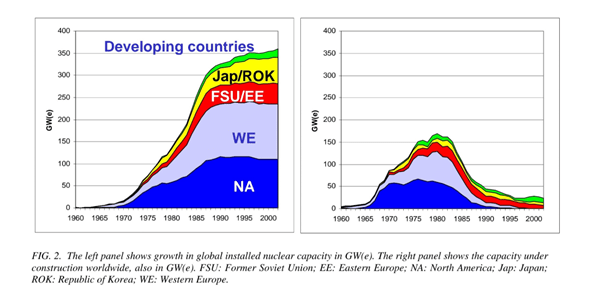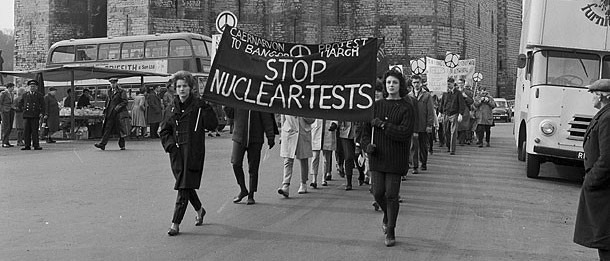How the world feared the atom because it feared the bomb
Since the industrial revolution in the late 18th century, the burning of coal and natural gases was the breakthrough for fundamental social change and catapulted us into the world we know today. However, we did not know when to stop. The IPCC (2021) report revealed that human activity (most notably the burning of fossil fuels) has been responsible for about 1.1C of global warming since 1850-1900, and at this same rate, the average global temperature will increase by another 1.5C in the next 20 years.
So where else can we look for clean energy? Environmentalists James Hansen and James Lovelock have asserted nuclear energy as a solution for the looming climate crisis. Nuclear fission is a technology that creates energy through the splitting of atoms, generating heat and releasing water vapour. Therefore, no carbon dioxide or other greenhouse gas emissions are released. In fact, today, France derives 70% of its electricity generation from nuclear power and boasts comparatively low rates of carbon emissions. However, nuclear energy can only be green if it is safe.
A single mistake could transform the Garden of Eden into hell, wiping out many of the achievements of human civilization
–Horace Herring
Following the Cuban Missile Crisis in the 1960s and the energy crises in the 1970s, anti-nuclear movements gained traction. Protesting the use of both nuclear weapons and nuclear energy, they called for complete nuclear disarmament in addition to alternate energy sources. In a review of Horace Herring’s From Energy Dreams to Nuclear Nightmares: Lessons from the Anti Nuclear Power Movement in the 1970s by Brett Clark, Brett Clark notes Herring’s eery assertion that “a single mistake could transform the Garden of Eden into hell, wiping out many of the achievements of human civilization.” This “hell” pertains to its potential to cause irreversible human and environmental harm, with risks such as ineffective nuclear waste management and disposal, the inevitable transferral of nuclear technology into weaponry and warfare, and the threat of human decimation at the hands of the nuclear bomb.
In line with calls for global peace, the development of nuclear energy suffered stagnation
While Hiroshima and Nagasaki are the looming faces of nuclear energy in the public eye, its commercial facets only began to prosper in the 1950s. 1951 saw the birth of the first electricity–generating nuclear reactor in Idaho, USA, albeit only a trivial amount. In 1953, US President Dwight Eisenhower announced a push for economic and civil development of nuclear energy use under his “Atoms for Peace” program, in an effort to deviate from the nuclear arms race. The USSR rendered the first nuclear power plant operational in 1954 in the city of Obninsk, and the world began to realise the potential of nuclear power as an alternate source of energy. By 1967, 50 power plants were ordered by the US utilities, and between 1967 and 1974, another 196 were ordered. Since then, technology has served to enhance the safety, sustainability, and reliability of nuclear power plants. However, in the 1970s, in line with calls for global peace, the development of nuclear energy suffered stagnation.

International Atomic Energy Agency
In the 1970s, communities across the globe called for peace. The anti-nuclear movement became one of many counterculture movements that gained prominence in the 1970s, amongst social protests such as the American involvement in the Vietnam War, the civil rights movement, but also environmental activism, with the first Earth Day taking place in 1970. In 1978, a rally drew 10,000 demonstrators at the UN’s First Special Session of the General Assembly Devoted to Disarmament, promoting the priority of phasing out nuclear weapon development and eliminating them all together. A year later, in 1979, another rally took place in New York, calling out corporate investment in nuclear weaponry. The same year, the Three Mile Island incident in Pennsylvania, US, exacerbated public fears about nuclear reactor safety and increased global public opposition to new construction of nuclear power plants. Subsequently, Chernobyl in 1986 shook Eastern Europe and fuelled the threat of destructive nuclear accidents. Environmentalist groups identified and reprobated thermal pollution caused by the steam seeping off nuclear cooling systems, as well as the issue of radioactive waste harming not only humans and living organisms, but the environment at large. In the 1980s, anti-nuclear movements called for cuts in funding the development of nuclear energy, production of nuclear power plants, and global nuclear disarmament.
Modern-age technology is brewing solutions to safety hazards
So, how has the situation changed since the 1970s?
Friends of the Earth, an environmental organisation founded in 1971, remains strongly opposed to the building of nuclear power plants in the UK. In their 2015 position paper on nuclear energy, they underline the dangers of radioactive waste that can remain hazardous for thousands of years and promote the deviation from nuclear energy development to that of renewable energies such as wind and solar, which “the UK is blessed with.” The Sierra Club, who organised Earth Day in 1970, “remains unequivocally opposed to nuclear energy.”
Nevertheless, it is safe to say that the movement’s efforts have been answered over the years. They raised a concrete, large-scale safety issue with nuclear energy development and demanded change. Arms-control agreements came to fruition between Mikhail Gorbachev and Ronald Reagan. International conventions and legal agreements have been enacted to control and dictate the conditions and requirements for nuclear development, such as the Convention on Nuclear Safety in 1996, and the Joint Convention on the Safety of Spent Fuel Management and on the Safety of Radioactive Waste Management in 2001. Modern-age technology is brewing solutions to safety hazards, such as nuclear reprocessing systems and radioactive disposal sites, with the likes of Finland’s Onkalo spent nuclear fuel repository.
Solutions are relentlessly being deliberated amongst scientists and policymakers. The question then shifts to whether anything will be enough to appease the public fear in order to indisputably consider nuclear power a viable alternative energy source once and for all.

Comments